San Joaquin (Tied For First))
| Stretch: | Mammoth Pool Reservoir to Powerhouse #8 |
| Difficulty: | Class IV+ to V |
| Distance: | 8.15 miles |
| Flows: | 600-2,000+ cfs. Current Dreamflows gauge |
| Gradient: | 89 fpm average (4.6 miles are 110 fpm) |
| Put-in: | Base of Mammoth Pool Reservoir |
| Take-out: | Powerhouse #8 |
| Shuttle: | 33 Miles (1:15 hours one-way) |
| Season: | Summer when it spills... or luck when there is maintenance |
| Written: | © 2011 |
| Featured in Video Fifty-Five | |
Where to start... I will just come out and say it. This is one of the best runs in the state. Period. Think of the classic nature of the rapids on Cherry Creek or 49 to Bridgeport. Now imagine massive granite walls rising all around you like in Devil's Canyon. Now make the canyon walls even more impressive, turn the forest into High Sierra, and make the rapids taller and fluffier. It is so good. The only downside is the shuttle that takes over one hour (though the shuttle does have some breathtaking views). And put that shuttle hours away from anywhere other than Fresno. Of course, this coupled with the fact that Edison Electric has had a strangle hold on the San Joaquin water for years makes it so this run tends to only be runnable at peak snow melt, at a time when the river diurnal will fall from 200 to 1,200 cfs in a few hours.
This year however, things are different. Thanks to an overhaul on the Powerhouse #8 at takeout, we got a nice and steady 1,000 cfs. What's more, is that it is projected to continue now for a total of 1.5 months! Also of course is the fact that 1,000 cfs is an optimum flow. Much like Cherry Creek, the river bed is big round boulders that swallow up low levels of water, necessitating a healthy flow just to fill in all the rocks. With this in mind, I know you can run the river down to 600 cfs or perhaps even lower, but I don't think I would want to go much lower than 800 cfs for a fun and clean day. Likewise, a little more water could be fun too. I would just be afraid of flows over 1,600 cfs personally, but then again folks Cherry Creek and 49 to B well into the 2,000's and beyond, so this would likely be their cup of tea.
The river starts off with some fun rapids between large pools. Soon though you will notice the rapids increasing in pace, length, and steepness. From this point until the end, it is game on. I would say only "The Sieve Rapid" and "Zero to Hero" are class V at 1,000 cfs. But I think a few other rapids have enough class IV+ moves linked together that a class V- rating for them is justified. Most rapids are on the hard end of class IV or class IV+. However, if you are a class IV+ boater leading your group down, you will be forced to scout endlessly making the river feel harder than I think it actually is. Many rapids appear to be huge and blind from above. Only once you enter (or scout) do you find out that intuition will lead you well through most of the rapids. If it is your first time and don't have someone in the know to lead you, I would plan on 5-6 hours on the water. With the lines dialed from our previous day's decent, we got down (with filming) in 1.5 hours. Our first day with filming was more like 4.5 hours with some scouting, some pool floating, and a lunch break. With all that said though, heed this warning... Hiking out of this canyon is not an option. Same goes for walking downriver. Once you are in it... you better win it. To make matters worse, the most gorged out section has the longest most technically challenging rapid of the run. A half mile of class IV+ moves would almost certainly result in a rough swim and likely separation from your gear. Once you gear is below the exit drop, I honestly am not sure how you could be reunited with it without swimming the exit hole (which was so big it causes folks who haven't swum in 10 years to swim). But don't let that scare you off... the rapid is actually a total hoot (yes, I said "hoot").
So in closing, I will say this... if this run had water regularly and was remotely close to a convenient location... it would be the most well liked class IV-V run in the state. I have no doubt about that. Also, for the interesting story about how the run got its name, read the Stanley/Holbek...
Mi 0.1:
- No Warm Up (IV to IV+). This run offers no warm up. Paddle down the massive granite wall, get through the log jam, and enter the first rapid. After a small lead in take the two ledges far right. The first is more of a low head dam that has the potential to start the day rough. Just below the second ledge (boof off the rock), is a nice boulder garden that is cleanest down the left. After this, the rapid provides a short distance of class III-IV between large pools to warm you up before you get to the good section.
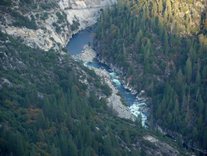
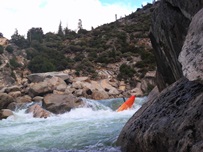
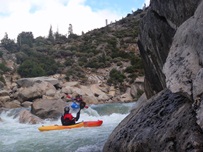
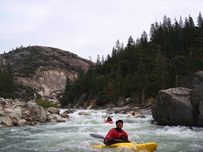
- Gauging station on the right. Both days we had 6.5' on the gauge.
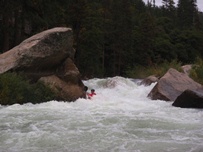
Blind (IV). There is a Blind rapid in here where the river splits around a house size rock and is totally blind from above. The right side is fine with just a few small holes.
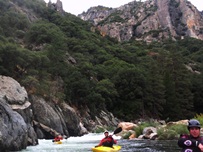
- S/H Portage #1 (IV to IV+). I can see how in 1982 this would have been a portage. As it is now, a portage is not needed as our plastic boats take rock abuse in stride. The rapid is totally blind from above, so scout left your first time or approach the lip with caution. Take the center channel and boof right of center. This sets you up to stay right through the next step and drop into the hole below.
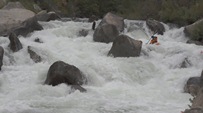
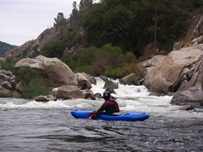
- Grandma's House (IV to IV+). Over the river and through the woods... you know you are here when the river enters a willow garden (obvious) and picks up speed before turning left over a series of ledges. Scout left. The rapid is blind until you are through the willows and committed. Once through the willows, drive left and negotiate the ledges which are all friendly at 1,000 cfs. The bottom ledge has a rock in the landing so boof the center rock around it. Below this rapid, are a few nice boofs down the right with juicy holes.
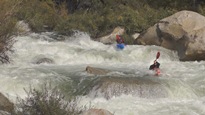
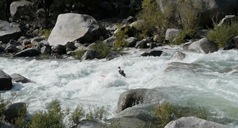
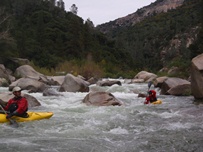
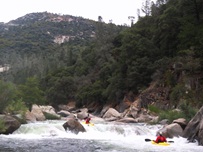
- Busy (IV). A long rapid that will keep you on your toes, best run down the left. This leads you to some very large boulders that have an undercut on the far left. Negotiate it and then exit out of the far right channel (big hole, get right around it) in the bottom step of the rapid. Not a rapid to swim.
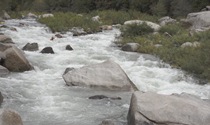
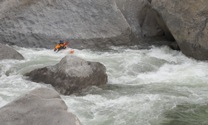
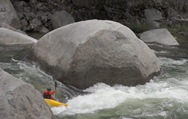
- Pre-Sieve (IV+). This is actually the top move of the sieve rapid as the outflow is the entry to the Sieve Rapid... so scout or portage this one if you have your doubts. Enter just left of the center rock and move right. Boof the 8 foot ledge below 2-3 feet off the right wall. There is a good size eddy immediately below. Most will choose to start your portage here.
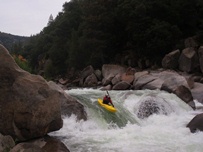
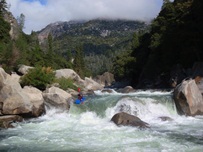
Sieve Rapid (V). Totally doable, but the fun to f?cked factor just isn't there. Plus, at lower water levels I think even the "clean" exit is a sieve. At 1,000 cfs the water pushes hard to the right where several large sieves await. Scout carefully or portage on the right with only moderate effort.
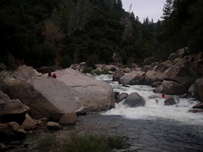
- First Half Mile (IV+). The first half mile long rapid is the easier one. Bigger eddies and smaller moves separate 6 or 7 class IV sub-rapids. We ran center and then work right. The exit is a folding seam that is a crap shoot on plugging (and flipping) and flushing. Out of the 10 lines we had down it, we only managed two lines that didn't plug.
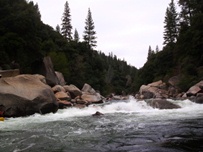
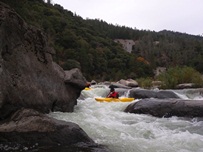
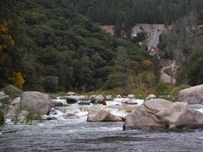
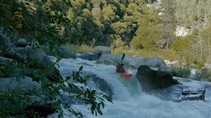
Another Blind (IV+). Another blind rapid with a house size boulder is just below the Half mile rapid. Enter center, drop through the first ledge and go right. This rapid appears to drop some 20-30 feet in total but somehow it is all rampy and no massive hole lurking.
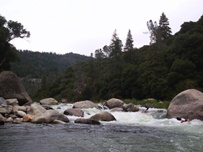
- Gorge Entry Rapids (IV to IV+). The walls start to rise around you and you will get nervous. It is starting to look very committing. This set of rapids is a half mile itself, but feels slower than either of the two Half Mile Rapids. Two moves of note, one is a right to left into a narrow sliding slot. The second is the exit (or entry into the gorge) which involves boofing the entry on the right and going through a folding seam that looks dubious as best but ramps out on the back side. You will then find yourself in a very cool gorge with granite walls towering above you for a thousand feet. We took lunch on the right just before the river started its final push to take-out.
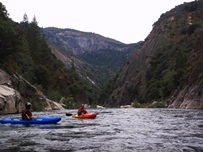
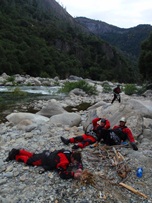
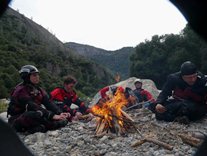
- Second Half Mile (V- to V). At 1,000 cfs this rapid was a series of class IV+ moves resulting in class V-. If the water was 2,000, it would be game on. As it was, I feel this is the crux of the run. Portaging the whole thing is not entirely an option, though you could portage down to the exit move... So, we entered left and worked right, and caught a small eddy on the left. The second step is the hardest and involves getting through a large hole at the top, and then going center into a folding cushion moving you back left and immediately dropping you into a hole back to the right. From there, more busyness leads you to the exit (see below)
Alliteration (IV+). This is the exit of the Second Half Mile rapid... If you don't know the rapid, you will likely want to scout from the right, though this also makes it so you have no speed for the move. A sloping drop into a hole with a pocket on the left and a rejection rock on the right. The move is to go right of center and boof through the hole. We had a swim out of the pocket and another near swim. Both flushed out fine. The second day we set safety here... We named the rapid because "Stefon Shelton's Swim Spot" just seemed a little long... And as it was his first swim in 11 years, we felt that should be honored. Plus, this hole is the most likely place for people to swim on the run. I know of 2 others on 2 of the 3 trips that have gone in...
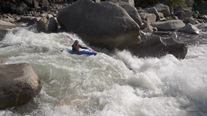
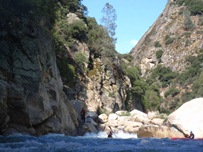
- Getting Nervous (IV). There is still a good section of long class IV rapids awaiting you before you get to the grand finale. They are all read and runnable. In this section is an awesome creek that drops down a large granite slop on the left (mi 6.1), it is really pretty. It also signals that you are getting close.
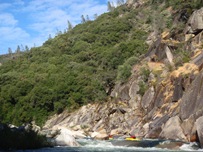
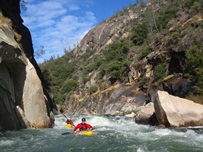
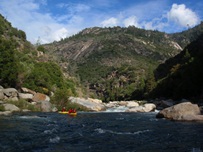
- Zero to Hero (V). Dilemma time, the portage starts prior to the class II-III lead in on the left. However the scout is at the lip on the right. The egress from the scout is difficult at best so once you scout... you are committed (unless you are super motivated to swim, paddle, and rope your boat back up). If you choose to run it, work you way down the far right and catch the 2 or 3 boat eddy at the lip on the right. Get out and scout. The line is to peal out and drive left for the first two foot boof. Then stay left and grind a mostly submerged rock and then drive left for the boof. Boof the 10 foot ledge and exit through the left chute. The hazards here actually aren't bad. They wouldn't be fun, but I think if you somehow mess it up in the entry you would drop the ledge on the right, plug through and flush down the exit on the right... you might gets some bruises, and you might swim... but I don't think (perhaps I was just trying to convince myself of this) that it would be the end. As it is, at 1,000 cfs it is pretty straight forward. As long as you drop the ledge on the left you don't even need to boof. The portage in on the left, requires a skree field traverse followed by either a 30 foot repel or a throw and go into the pool below.
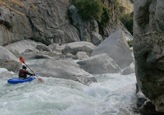
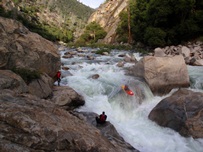
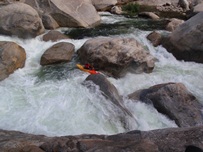
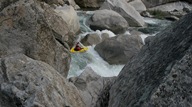
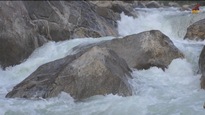
Paddle Out (III-IV). Three or Four more rapids await and before you know it (10-15 minutes) later you are at your car.
Take-out: From the town of North Fork, take Rd 225/Mammoth Pool Rd. Follow this for 13.8 miles. Look for the sign for the Powerhouse to drop down on a road to the right (Rd 8S03), if you see a Historic Cabin or an Apple Orchard Plantation you have gone a half mile too far.. Follow this some 3 miles down to the gravel lot near the powerhouse.
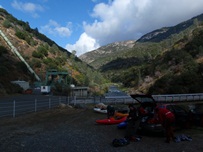
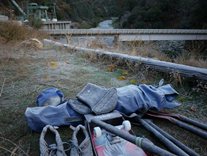
Put-in: Get back up to Mammoth Pool Rd and continue for 27.3 miles. Look for signs to Mammoth Pool... the first turn is marked 6S25. At times the road is closed due to deer migration (no joke). It is another 3.2 miles from this point... Follow the road around the lake to just past the spill way where there is a gated road to hike down to the base of the dam.
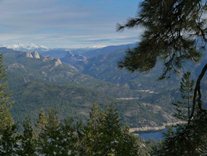
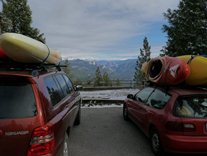
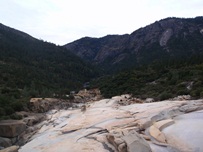
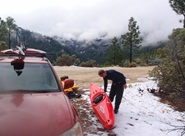
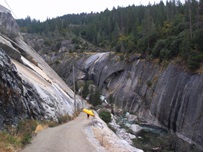
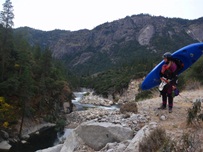
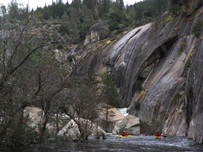
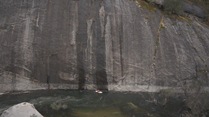
View San Joaquin, Tied for First in a larger map
HTML Comment Box is loading comments...
